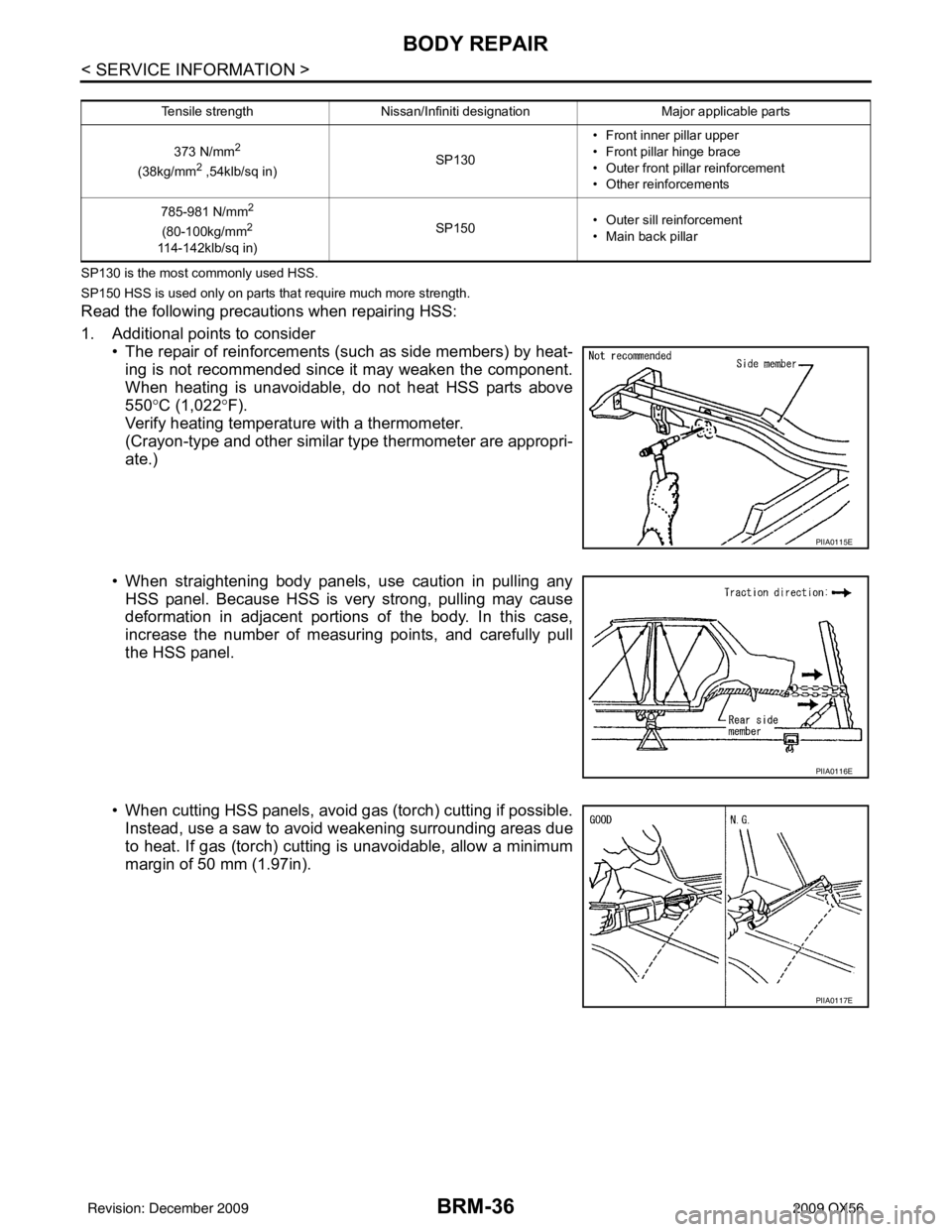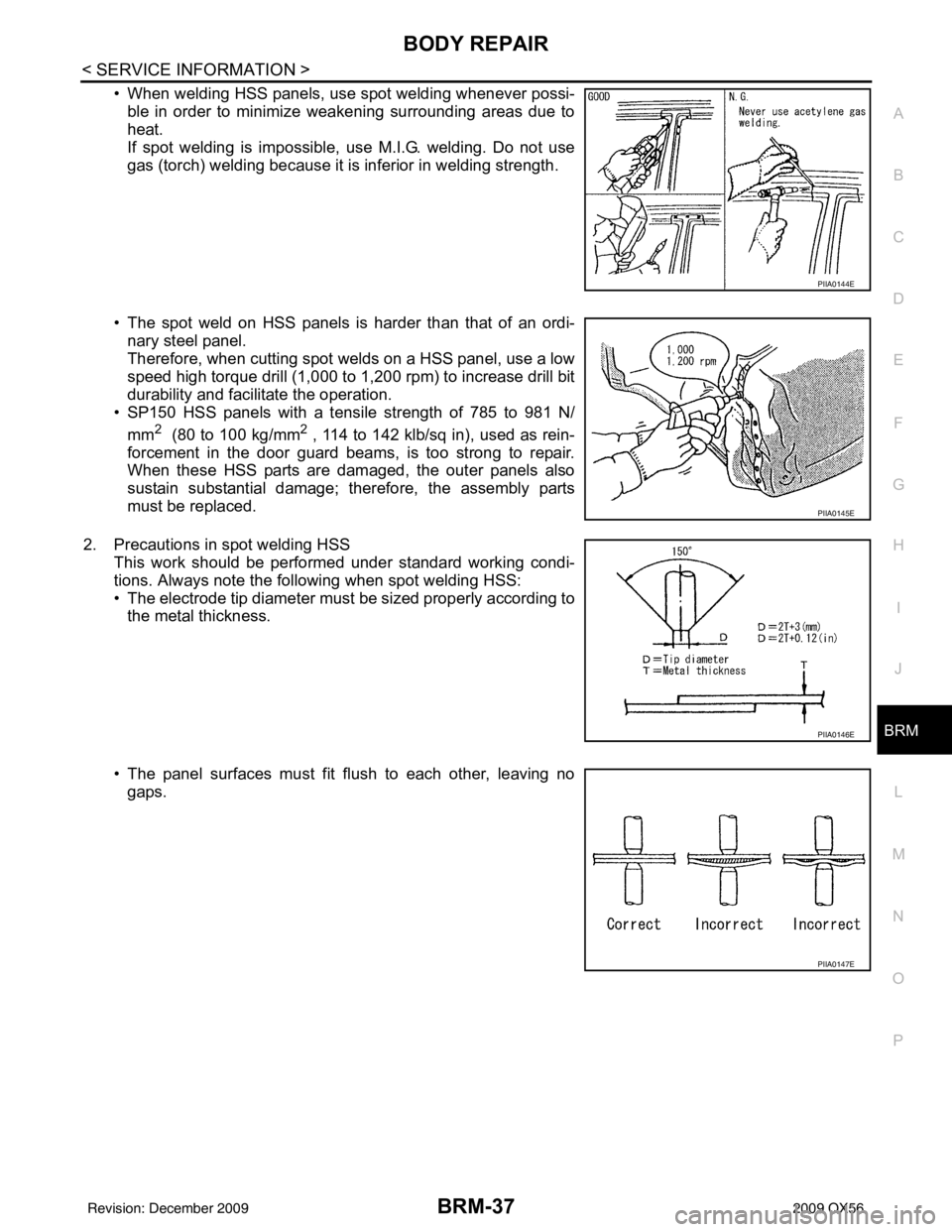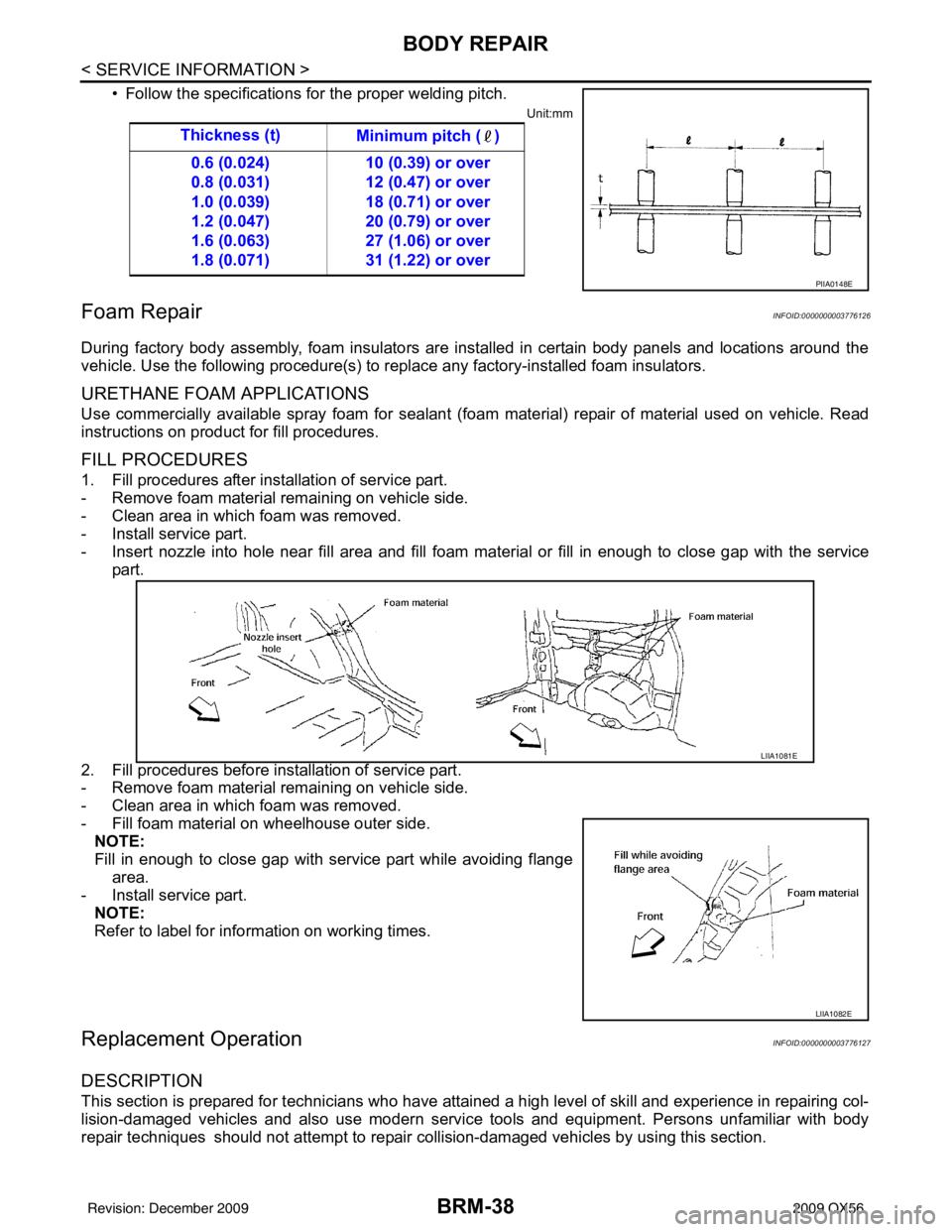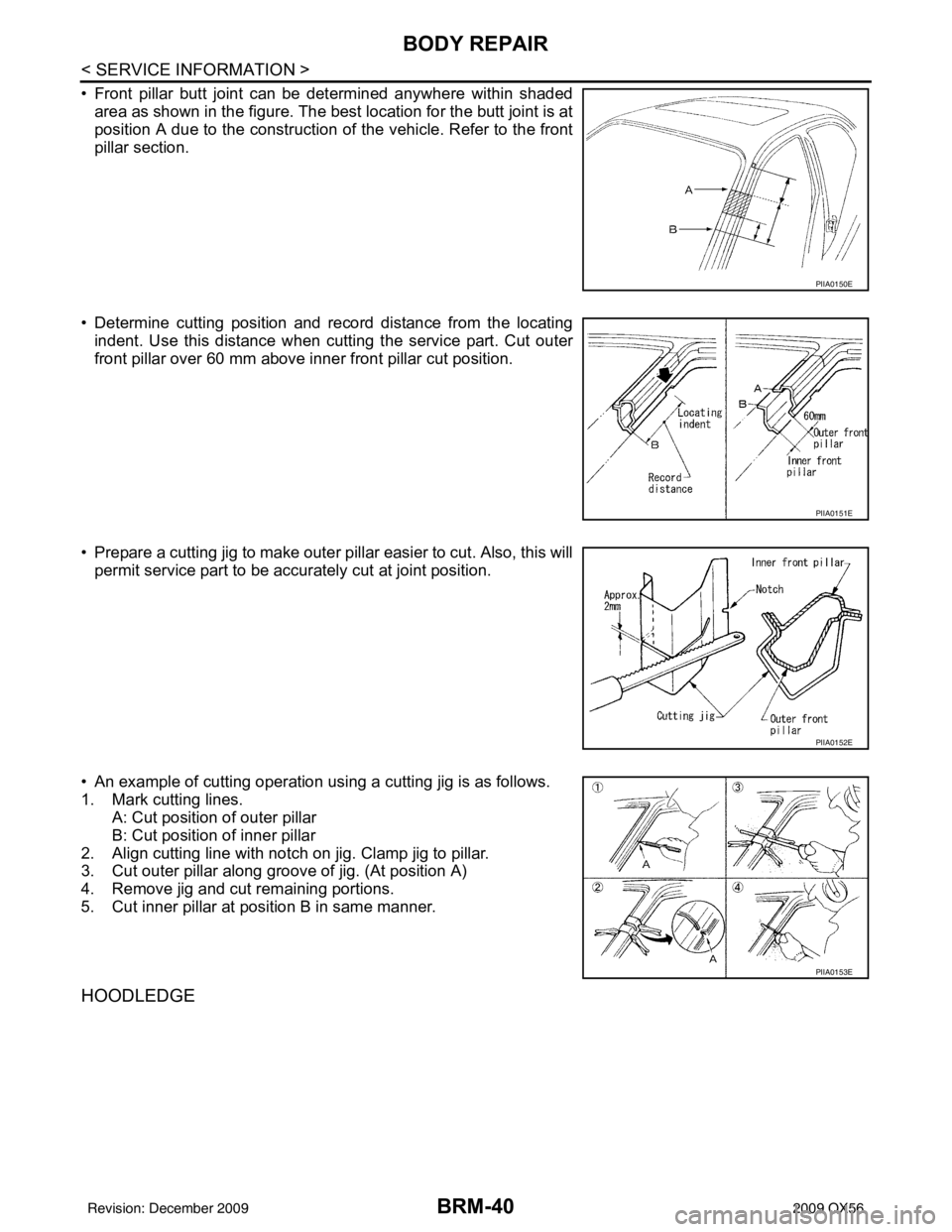INFINITI QX56 2009 Factory Service Manual
QX56 2009
INFINITI
INFINITI
https://www.carmanualsonline.info/img/42/57031/w960_57031-0.png
INFINITI QX56 2009 Factory Service Manual
Trending: width, driver seat adjustment, Rear axle, turn signal bulb, child restraint, battery, engine
Page 631 of 4171
BODY REPAIRBRM-35
< SERVICE INFORMATION >
C
DE
F
G H
I
J
L
M A
B
BRM
N
O P
MEASUREMENT POINTS
Precaution in Repairing High Strength SteelINFOID:0000000003776125
High strength steel is used for body panels in order to reduce vehicle weight.
Accordingly, precautions in repairing automotive bodies made of high strength steel are described below:
High strength steel (hss)
used in nissan vehicles
LIIA1107E
Revision: December 20092009 QX56
Page 632 of 4171

BRM-36
< SERVICE INFORMATION >
BODY REPAIR
SP130 is the most commonly used HSS.
SP150 HSS is used only on parts that require much more strength.
Read the following precautions when repairing HSS:
1. Additional points to consider• The repair of reinforcements (such as side members) by heat-ing is not recommended since it may weaken the component.
When heating is unavoidable, do not heat HSS parts above
550° C (1,022° F).
Verify heating temperature with a thermometer.
(Crayon-type and other similar type thermometer are appropri-
ate.)
• When straightening body panels, use caution in pulling any HSS panel. Because HSS is very strong, pulling may cause
deformation in adjacent portions of the body. In this case,
increase the number of measuring points, and carefully pull
the HSS panel.
• When cutting HSS panels, avoid gas (torch) cutting if possible. Instead, use a saw to avoid weakening surrounding areas due
to heat. If gas (torch) cutting is unavoidable, allow a minimum
margin of 50 mm (1.97in).
Tensile strength Nissan/Infiniti designation Major applicable parts
373 N/mm
2
(38kg/mm2 ,54klb/sq in) SP130• Front inner pillar upper
• Front pillar hinge brace
• Outer front pillar reinforcement
• Other reinforcements
785-981 N/mm
2
(80-100kg/mm2
114-142klb/sq in) SP150
• Outer sill reinforcement
• Main back pillar
PIIA0115E
PIIA0116E
PIIA0117E
Revision: December 20092009 QX56
Page 633 of 4171

BODY REPAIRBRM-37
< SERVICE INFORMATION >
C
DE
F
G H
I
J
L
M A
B
BRM
N
O P
• When welding HSS panels, use spot welding whenever possi- ble in order to minimize weakening surrounding areas due to
heat.
If spot welding is impossible, use M.I.G. welding. Do not use
gas (torch) welding because it is inferior in welding strength.
• The spot weld on HSS panels is harder than that of an ordi- nary steel panel.
Therefore, when cutting spot welds on a HSS panel, use a low
speed high torque drill (1,000 to 1,200 rpm) to increase drill bit
durability and facilitate the operation.
• SP150 HSS panels with a tensile strength of 785 to 981 N/
mm
2 (80 to 100 kg/mm2 , 114 to 142 klb/sq in), used as rein-
forcement in the door guard beams, is too strong to repair.
When these HSS parts are damaged, the outer panels also
sustain substantial damage; therefore, the assembly parts
must be replaced.
2. Precautions in spot welding HSS This work should be performed under standard working condi-
tions. Always note the following when spot welding HSS:
• The electrode tip diameter must be sized properly according tothe metal thickness.
• The panel surfaces must fit flush to each other, leaving no gaps.
PIIA0144E
PIIA0145E
PIIA0146E
PIIA0147E
Revision: December 20092009 QX56
Page 634 of 4171

BRM-38
< SERVICE INFORMATION >
BODY REPAIR
• Follow the specifications for the proper welding pitch.
Unit:mm
Foam RepairINFOID:0000000003776126
During factory body assembly, foam insulators are installed in certain body panels and locations around the
vehicle. Use the following procedure(s) to replace any factory-installed foam insulators.
URETHANE FOAM APPLICATIONS
Use commercially available spray foam for sealant (foam material) repair of material used on vehicle. Read
instructions on product for fill procedures.
FILL PROCEDURES
1. Fill procedures after installation of service part.
- Remove foam material remaining on vehicle side.
- Clean area in which foam was removed.
- Install service part.
- Insert nozzle into hole near fill area and fill foam material or fill in enough to close gap with the service part.
2. Fill procedures before installation of service part.
- Remove foam material remaining on vehicle side.
- Clean area in which foam was removed.
- Fill foam material on wheelhouse outer side. NOTE:
Fill in enough to close gap with service part while avoiding flange
area.
- Install service part.
NOTE:
Refer to label for information on working times.
Replacement OperationINFOID:0000000003776127
DESCRIPTION
This section is prepared for technicians who have attained a high level of skill and experience in repairing col-
lision-damaged vehicles and also use modern servic e tools and equipment. Persons unfamiliar with body
repair techniques should not attempt to repair collision-damaged vehicles by using this section. Thickness (t)
Minimum pitch ( )
0.6 (0.024)
0.8 (0.031)
1.0 (0.039)
1.2 (0.047)
1.6 (0.063)
1.8 (0.071) 10 (0.39) or over
12 (0.47) or over
18 (0.71) or over
20 (0.79) or over
27 (1.06) or over
31 (1.22) or over
PIIA0148E
LIIA1081E
LIIA1082E
Revision: December 20092009 QX56
Page 635 of 4171
BODY REPAIRBRM-39
< SERVICE INFORMATION >
C
DE
F
G H
I
J
L
M A
B
BRM
N
O P
Technicians are also encouraged to read Body Repair Manual (Fundamentals) in order to ensure that the orig-
inal functions and quality of the vehicle can be maintained. The Body Repair Manual (Fundamentals) contains
additional information, including cautions and warnings, that are not including in this manual. Technicians
should refer to both manuals to ensure proper repairs.
Please note that this information is prepared for worldwide usage, and as such, certain procedures may not
apply in some regions or countries.
The symbols used in this section for cutting and welding / brazing operations are shown below.
PIIA0149E
Revision: December 20092009 QX56
Page 636 of 4171

BRM-40
< SERVICE INFORMATION >
BODY REPAIR
• Front pillar butt joint can be determined anywhere within shadedarea as shown in the figure. The best location for the butt joint is at
position A due to the construction of the vehicle. Refer to the front
pillar section.
• Determine cutting position and record distance from the locating indent. Use this distance when cutt ing the service part. Cut outer
front pillar over 60 mm above inner front pillar cut position.
• Prepare a cutting jig to make outer pillar easier to cut. Also, this will permit service part to be accurately cut at joint position.
• An example of cutting operation using a cutting jig is as follows.
1. Mark cutting lines. A: Cut position of outer pillar
B: Cut position of inner pillar
2. Align cutting line with notch on jig. Clamp jig to pillar.
3. Cut outer pillar along groove of jig. (At position A)
4. Remove jig and cut remaining portions.
5. Cut inner pillar at position B in same manner.
HOODLEDGE
PIIA0150E
PIIA0151E
PIIA0152E
PIIA0153E
Revision: December 20092009 QX56
Page 637 of 4171
BODY REPAIRBRM-41
< SERVICE INFORMATION >
C
DE
F
G H
I
J
L
M A
B
BRM
N
O P
• Work after radiator core support has been removed.
FRONT PILLAR
LIIA1154E
Revision: December 20092009 QX56
Page 638 of 4171
BRM-42
< SERVICE INFORMATION >
BODY REPAIR
• Work after rear hoodledge reinforcement has been removed.
LIIA1108E
Revision: December 20092009 QX56
Page 639 of 4171
BODY REPAIRBRM-43
< SERVICE INFORMATION >
C
DE
F
G H
I
J
L
M A
B
BRM
N
O P
LIIA1109E
Revision: December 20092009 QX56
Page 640 of 4171
BRM-44
< SERVICE INFORMATION >
BODY REPAIR
LIIA1110E
Revision: December 20092009 QX56
Trending: diagnostic menu, remove seats, check transmission fluid, coolant level, tire type, wiring diagram, transmission oil









